

Compact Muon Solenoid
LHC, CERN
| CMS-PAS-FTR-18-018 | ||
| First level track jet trigger for displaced jets at High Luminosity LHC | ||
| CMS Collaboration | ||
| November 2018 | ||
| Abstract: The CMS detector for the planned high luminosity LHC run will have a new first level (L1) hardware track trigger. The impact of the L1 track trigger is explored based on the potential increase of CMS sensitivity to signals beyond the standard model in final states with multiple jets and low total transverse energy. In particular, there is currently an blind spot for lifetimes of order 1 cm in searches for new long-lived scalars $\phi$ in Higgs decays, i.e. $\text{H}(125)\to \phi\phi \to $ 4j. It is found that a plausible extension of the L1 track trigger to tracks with an impact parameter of a few centimeters results in dramatic gains in the trigger efficiency. The gains are even larger for additional heavy SM-like Higgs bosons with the same decay. | ||
| Links: CDS record (PDF) ; inSPIRE record ; CADI line (restricted) ; | ||
| Figures | |

png pdf |
Figure 1:
The efficiency for a jet to give rise to a L1 track jet as a function of the generator-level ${p_{\mathrm {T}}}$ of the jet. The light and dark blue lines correspond to the trigger clustering (TwoLayer Jets) and anti-$ {k_{\mathrm {T}}}$ with $R =$ 0.3 (FastJet), respectively. |

png pdf |
Figure 2:
Calculated L1 trigger rates for track jet based ${H_{\mathrm {T}}}$ (left) and quad-jet (right) triggers. The light and dark blue lines correspond to the trigger clustering (TwoLayer Jets) and anti-$ {k_{\mathrm {T}}}$ with $R =$ 0.3 (FastJet), respectively. |
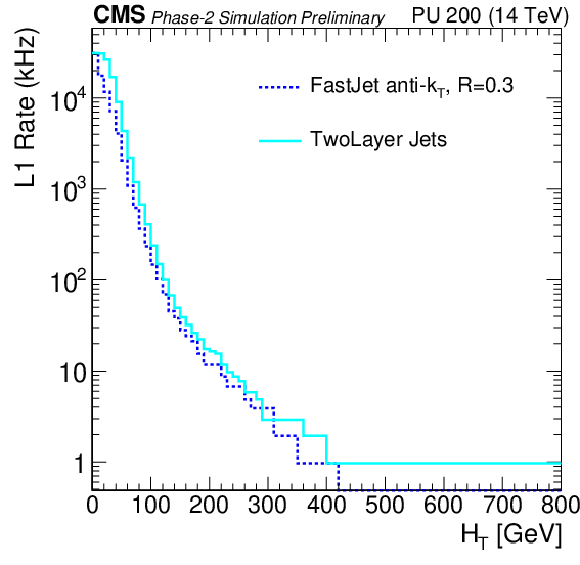
png pdf |
Figure 2-a:
Calculated L1 trigger rates for track jet based ${H_{\mathrm {T}}}$ triggers. The light and dark blue lines correspond to the trigger clustering (TwoLayer Jets) and anti-$ {k_{\mathrm {T}}}$ with $R =$ 0.3 (FastJet), respectively. |
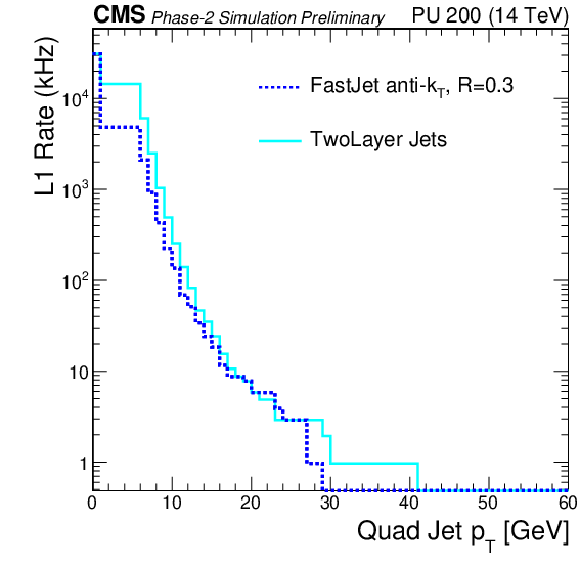
png pdf |
Figure 2-b:
Calculated L1 trigger rates for track jet based quad-jet triggers. The light and dark blue lines correspond to the trigger clustering (TwoLayer Jets) and anti-$ {k_{\mathrm {T}}}$ with $R =$ 0.3 (FastJet), respectively. |
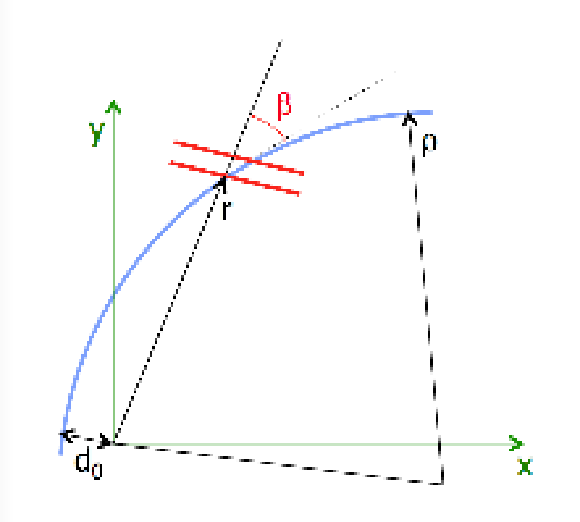
png pdf |
Figure 3:
A sketch of a track crossing a ${p_{\mathrm {T}}} $-module. |
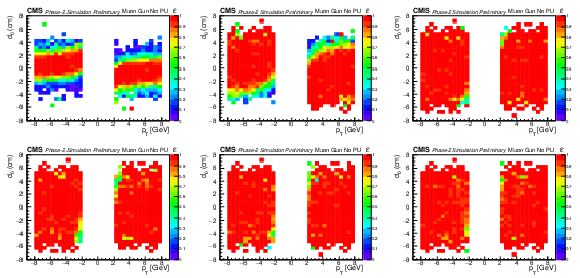
png pdf |
Figure 4:
The efficiency for a displaced muon to form stubs in the six barrel layers of the Phase-2 tracker, as a function of the signed muon ${p_{\mathrm {T}}}$ and impact parameter. The top row shows, from left to right, layers 1, 2, and 3; the bottom row shows layers 4, 5, and 6. The sample is comprised of 2000 muons generated with uniformly distributed transverse momentum between 2 and 8 GeV and pseudorapidity $|\eta | < $ 1, and with the impact parameter ${d_0}$ distributed as a Gaussian with width of 2 cm. |
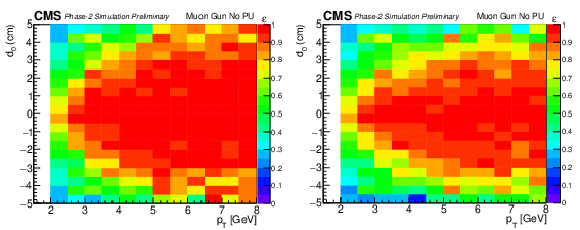
png pdf |
Figure 5:
The efficiency for a displaced muon to be reconstructed as a track with at least four stubs (left) and at least five stubs (right). |
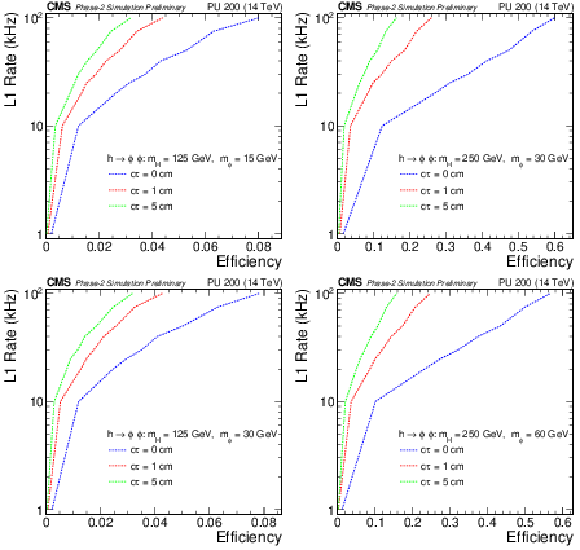
png pdf |
Figure 6:
The rate of the track jet $ {H_{\mathrm {T}}} $ trigger as a function of signal efficiency for the SM-like Higgs boson (left) and the heavy SM-like Higgs boson (right) using prompt track finding. |
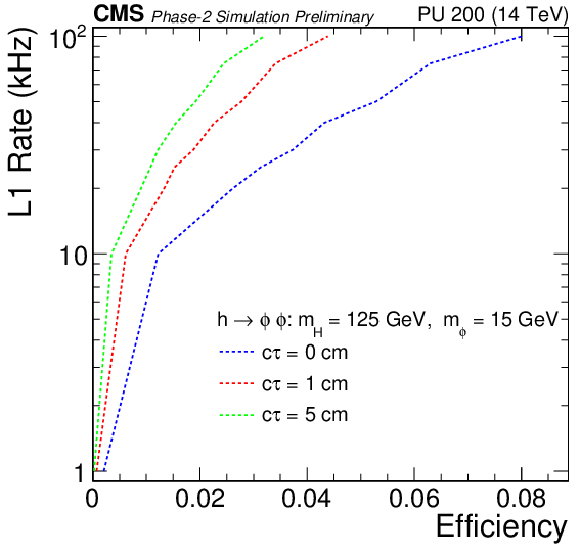
png pdf |
Figure 6-a:
The rate of the track jet $ {H_{\mathrm {T}}} $ trigger as a function of signal efficiency for $m_{\mathrm{H}} = $ 125 GeV and $m_{\phi} = $ 15 GeV, using prompt track finding. |
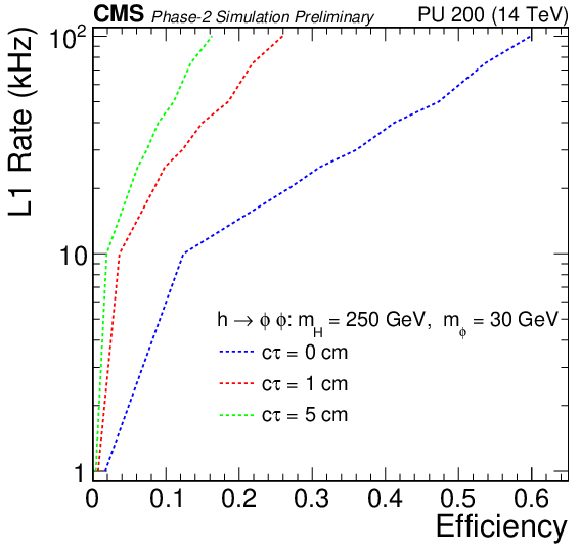
png pdf |
Figure 6-b:
The rate of the track jet $ {H_{\mathrm {T}}} $ trigger as a function of signal efficiency for $m_{\mathrm{H}} = $ 250 GeV and $m_{\phi} = $ 30 GeV, using prompt track finding. |
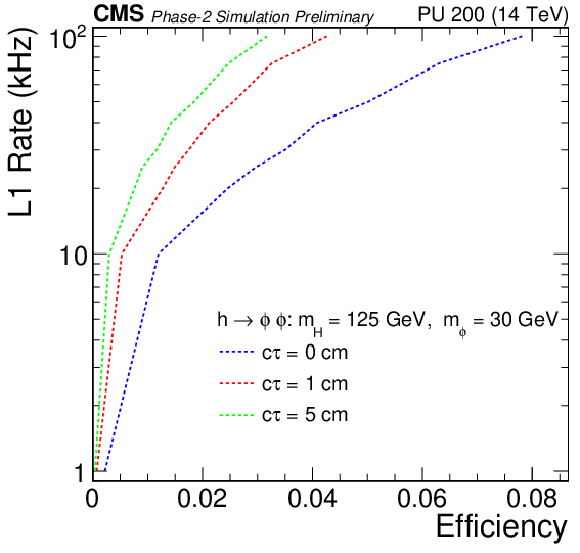
png pdf |
Figure 6-c:
The rate of the track jet $ {H_{\mathrm {T}}} $ trigger as a function of signal efficiency for $m_{\mathrm{H}} = $ 125 GeV and $m_{\phi} = $ 30 GeV, using prompt track finding. |
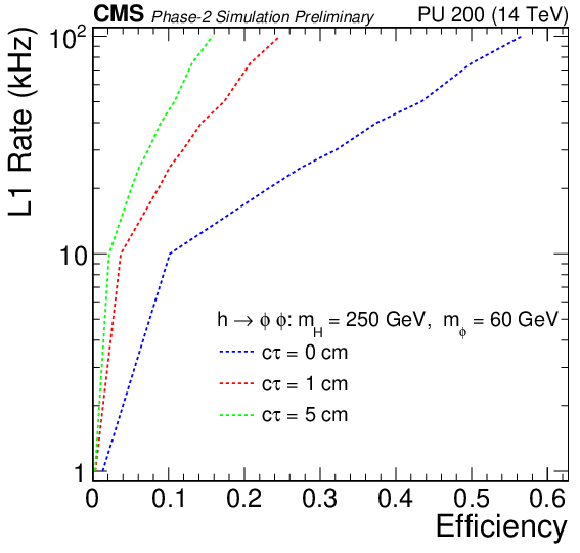
png pdf |
Figure 6-d:
The rate of the track jet $ {H_{\mathrm {T}}} $ trigger as a function of signal efficiency for $m_{\mathrm{H}} = $ 250 GeV and $m_{\phi} = $ 60 GeV, using prompt track finding. |
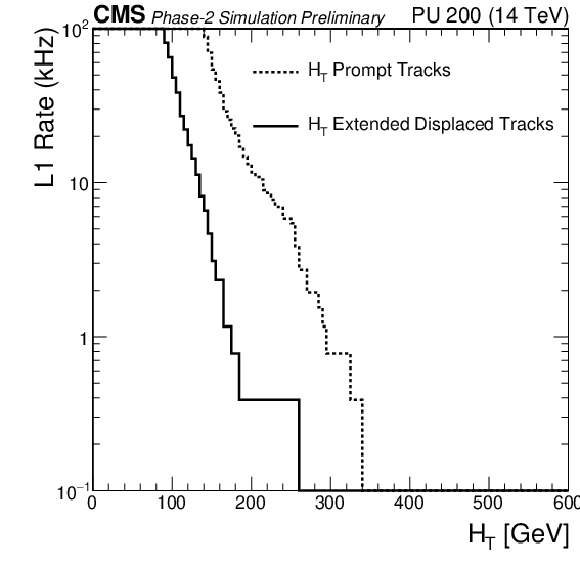
png pdf |
Figure 7:
The rate of the track jet $ {H_{\mathrm {T}}} $ trigger using extended track finding with (solid line) and without (dashed line) a requirement of at least one jet with a displaced tag. |
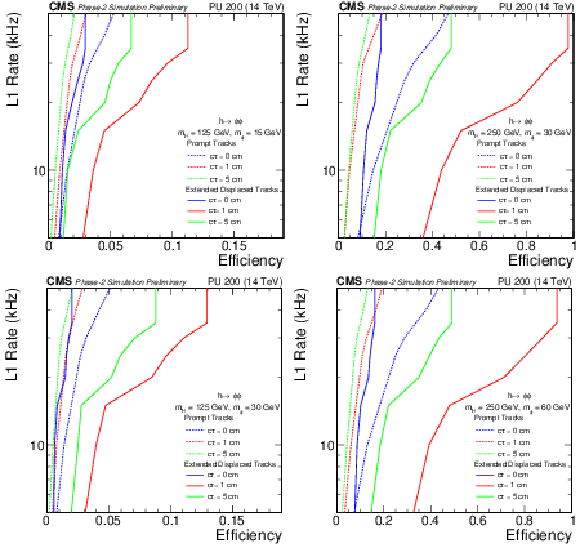
png pdf |
Figure 8:
The rate of the track jet $ {H_{\mathrm {T}}} $ trigger as a function of signal efficiency using extended track finding for the SM-like Higgs (left) and the heavy SM-like Higgs (right). The extended track finding performance is extrapolated to the full outer tracker acceptance as described in text. |
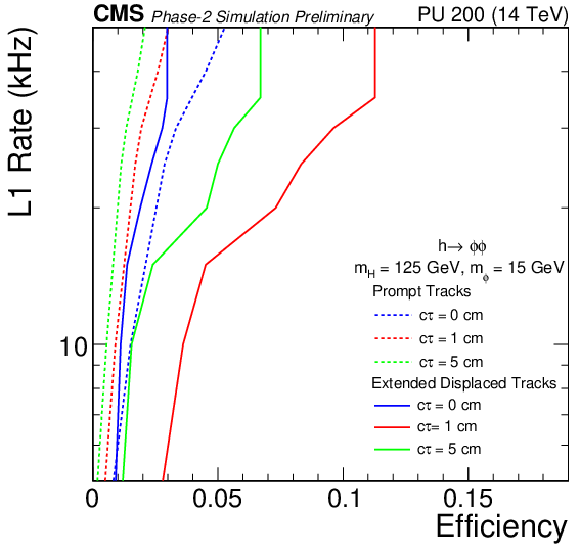
png pdf |
Figure 8-a:
The rate of the track jet $ {H_{\mathrm {T}}} $ trigger as a function of signal efficiency using extended track finding for $m_{\mathrm{H}} = $ 125 GeV and $m_{\phi} = $ 15 GeV. The extended track finding performance is extrapolated to the full outer tracker acceptance as described in text. |
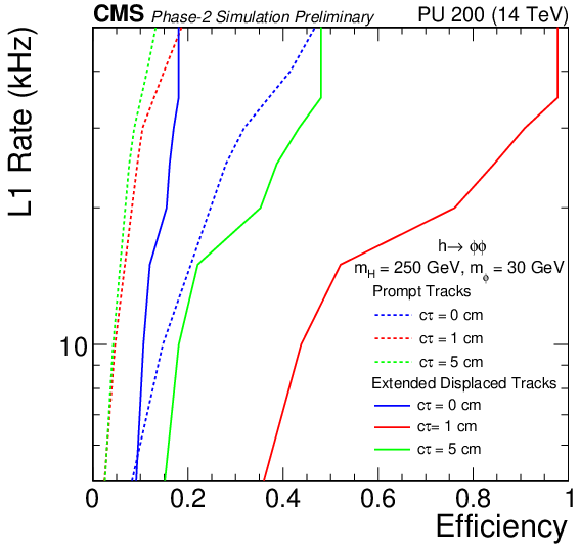
png pdf |
Figure 8-b:
The rate of the track jet $ {H_{\mathrm {T}}} $ trigger as a function of signal efficiency using extended track finding for $m_{\mathrm{H}} = $ 250 GeV and $m_{\phi} = $ 30 GeV. The extended track finding performance is extrapolated to the full outer tracker acceptance as described in text. |
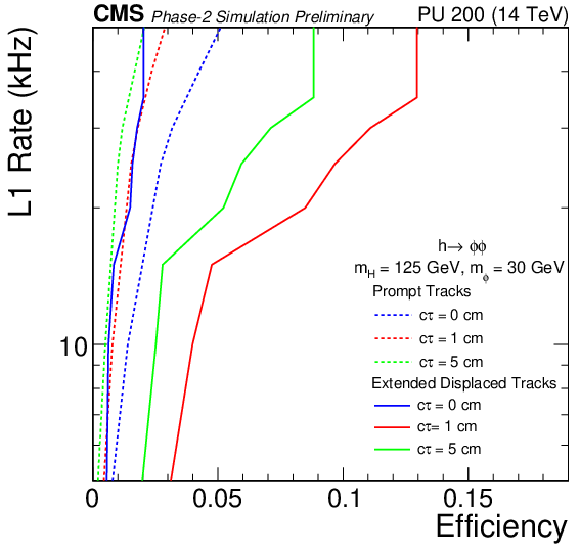
png pdf |
Figure 8-c:
The rate of the track jet $ {H_{\mathrm {T}}} $ trigger as a function of signal efficiency using extended track finding for $m_{\mathrm{H}} = $ 125 GeV and $m_{\phi} = $ 30 GeV. The extended track finding performance is extrapolated to the full outer tracker acceptance as described in text. |
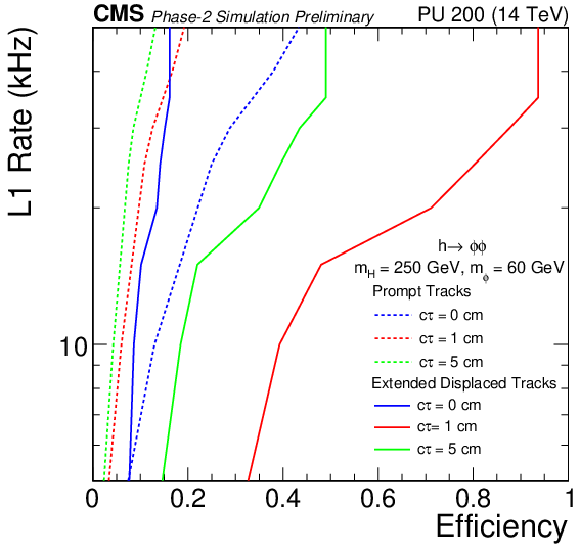
png pdf |
Figure 8-d:
The rate of the track jet $ {H_{\mathrm {T}}} $ trigger as a function of signal efficiency using extended track finding for $m_{\mathrm{H}} = $ 250 GeV and $m_{\phi} = $ 60 GeV. The extended track finding performance is extrapolated to the full outer tracker acceptance as described in text. |
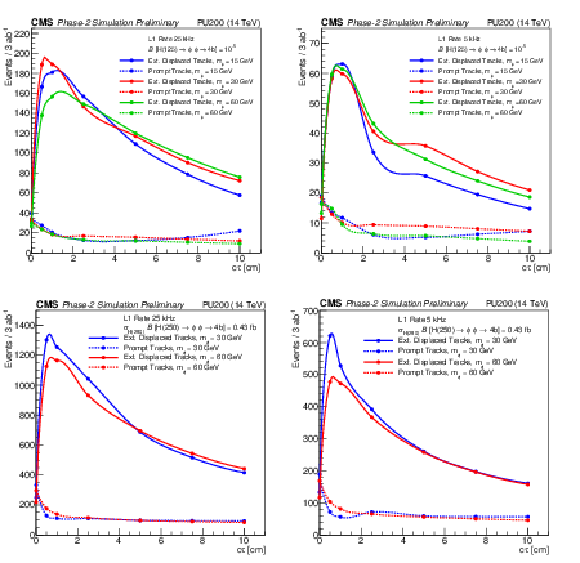
png pdf |
Figure 9:
This plot shows the number of triggered Higgs events (assuming ${\mathcal {B}[ {{\mathrm {H}} (125)\to \phi \phi \to 4j} ] = 10^{-5}}$, corresponding to 1700 events) as a function of ${c\tau}$ for two choices for the trigger rates: 25 kHz (left), 5 kHz (right). Two triggers are compared: one based on prompt track finding (dotted lines) and another that is based on extended track finding with a displaced jet tag (solid lines). |
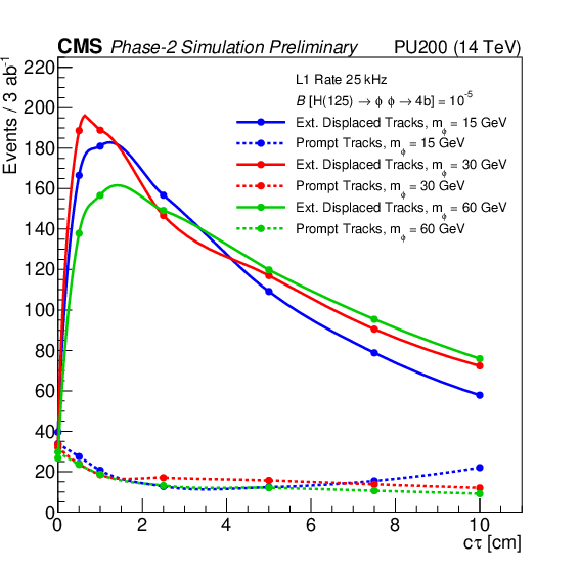
png pdf |
Figure 9-a:
This plot shows the number of triggered Higgs events (assuming ${\mathcal {B}[ {{\mathrm {H}} (125)\to \phi \phi \to 4j} ] = 10^{-5}}$, corresponding to 1700 events) as a function of ${c\tau}$ for 25 kHz trigger rate. Two triggers are compared: one based on prompt track finding (dotted lines) and another that is based on extended track finding with a displaced jet tag (solid lines). |
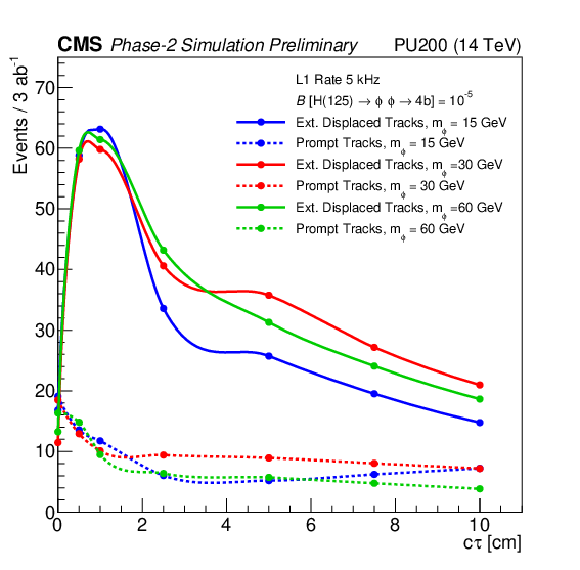
png pdf |
Figure 9-b:
This plot shows the number of triggered Higgs events (assuming ${\mathcal {B}[ {{\mathrm {H}} (125)\to \phi \phi \to 4j} ] = 10^{-5}}$, corresponding to 1700 events) as a function of ${c\tau}$ for 5 kHz trigger rate. Two triggers are compared: one based on prompt track finding (dotted lines) and another that is based on extended track finding with a displaced jet tag (solid lines). |
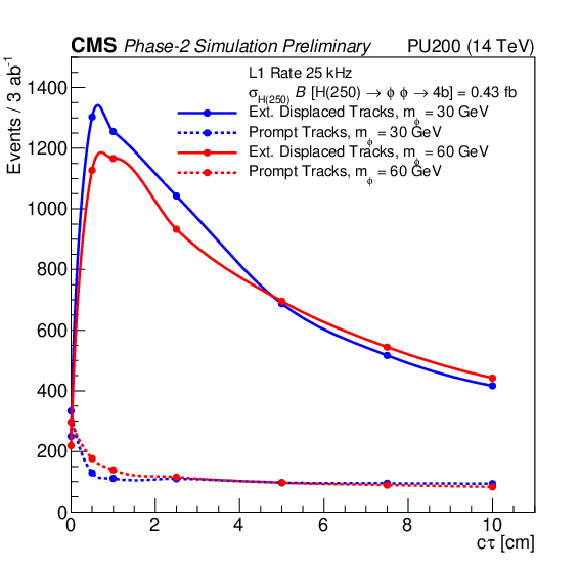
png pdf |
Figure 9-c:
This plot shows the number of triggered events (assuming $\sigma_{\mathrm {H} (250)}{\mathcal {B}[ {{\mathrm {H}} (250)\to \phi \phi \to 4b} ]} =$ 0.43 fb) as a function of ${c\tau}$ for 25 kHz trigger rate. Two triggers are compared: one based on prompt track finding (dotted lines) and another that is based on extended track finding with a displaced jet tag (solid lines). |
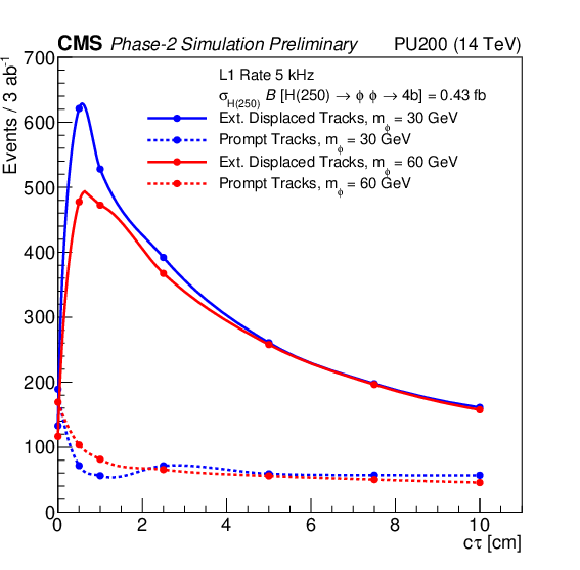
png pdf |
Figure 9-d:
This plot shows the number of triggered events (assuming $\sigma_{\mathrm {H} (250)}{\mathcal {B}[ {{\mathrm {H}} (250)\to \phi \phi \to 4b} ]} = $ 0.43 fb) as a function of ${c\tau}$ for 5 kHz trigger rate. Two triggers are compared: one based on prompt track finding (dotted lines) and another that is based on extended track finding with a displaced jet tag (solid lines). |
| Tables | |

png pdf |
Table 1:
Track selection for jet finding. The $\chi ^2$ selections are per degree of freedom for a 4-parameter track fit. |

png pdf |
Table 2:
Track selection criteria for jet finding with extended L1 track finding. |
| Summary |
|
We have studied the upgraded CMS detector's ability to trigger on events with long lived particles decaying into jets. Currently, such events pass the L1 trigger only if the total transverse energy in the event is above a few hundred GeVns. This is an important blind spot for searches, especially for the rare exotic Higgs boson decays like ${\mathrm{H}(125)\to \phi\phi \to 4j} $. In this note, a new L1 trigger strategy based on the Phase-2 CMS detector's ability to find tracks at L1 is explored. Using L1 tracks for jet reconstruction significantly suppresses pile-up and allows to accept events with lower ${H_{\mathrm{T}}}$. For the exotic Higgs decays considered, given the total Phase-2 dataset of 3 ab$^{-1}$ and branching fraction of $10^{-5}$, CMS would collect $\mathcal{O}$(10) events, which should be sufficient for discovery. We also considered a plausible extension of the L1 track finder to consider tracks with impact parameters of a few cm. That approach improves the yield by more than an order of magnitude. The gains for the extended L1 track finding are even larger for the events with larger ${H_{\mathrm{T}}}$, as demonstrated by the simulations of heavy Higgs boson decays. |
| References | ||||
| 1 | CMS Collaboration | The Phase-2 Upgrade of the CMS Tracker | CDS | |
| 2 | CMS Collaboration | The Phase-2 Upgrade of the CMS Barrel Calorimeter | CDS | |
| 3 | CMS Collaboration | The Phase-2 Upgrade of the CMS Endcap Calorimeter | CDS | |
| 4 | CMS Collaboration | The Phase-2 Upgrade of the CMS Muon Detectors | CDS | |
| 5 | CMS Collaboration | The Phase-2 Upgrade of the CMS L1 Trigger Interim Technical Design Report | CDS | |
| 6 | CMS Collaboration | Search for long-lived particles with displaced vertices in multijet events in pp collision events at $ \sqrt{s} = $ 13 TeV | Submitted to PRD | CMS-EXO-17-018 1808.03078 |
| 7 | ATLAS Collaboration | Search for the Higgs boson produced in association with a vector boson and decaying into two spin-zero particles in the $ H \rightarrow aa \rightarrow 4b $ channel in $ pp $ collisions at $ \sqrt{s} = $ 13 TeV with the ATLAS detector | JHEP 10 (2018) 031 | 1806.07355 |
| 8 | CMS Collaboration | Search for new long-lived particles at $ \sqrt{s} = $ 13 TeV | PLB 780 (2017) 432 | |
| 9 | D. Curtin et al. | Exotic decays of the 125 GeV Higgs boson | PRD 90 (2014) 075004 | 1312.4992 |
| 10 | GEANT4 Collaboration | GEANT4--a simulation toolkit | NIMA 506 (2003) 250 | |
| 11 | S. Alioli, P. Nason, C. Oleari, and E. Re | NLO Higgs boson production via gluon fusion matched with shower in POWHEG | JHEP 04 (2009) 002 | 0812.0578 |
| 12 | T. Sjostrand et al. | An Introduction to PYTHIA 8.2 | CPC 191 (2015) 159--177 | 1410.3012 |
| 13 | M. Cacciari, G. P. Salam, and G. Soyez | The anti-$ {k_{\mathrm{T}}} $ jet clustering algorithm | JHEP 04 (2008) 063 | 0802.1189 |
| 14 | M. Cacciari, G. P. Salam, and G. Soyez | FastJet User Manual | EPJC 72 (2012) 1896 | 1111.6097 |

|
Compact Muon Solenoid LHC, CERN |

|

|

|

|

|

|